April 21, 2021 – Pueblo Tailwater
Flows: 90 cfs.
Water Temp: 46F @ 8:30a.
Water clarity: Crystal clear
Air Temp: 34 @ 8:30a, 48 @ 4p.
Hatches: Midge – Heavy hatch starting at ~9a and lasting all day. Sparse BWO – 12N to 3:30p.
This looked similar to what we saw flying overhead as we got ready to fish.
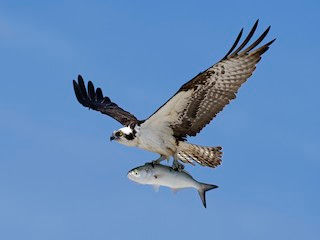
From "birdsoftheworld.com".
Flies: #18 Hare’s Ear, #22 Black Beauty, #22, 24, 26 Top Secret Midge, #18 Mercury Pheasant Tail, #24 Jujubee Zebra Midge, #22 Olive Foamback Emerger, #24 Sparkle Dun, #22 Parachute BWO, #24 Matt’s Midge, #22 Balck Parachute, #24 Mercury Black Zebra Midge, #22 Black Midge.
Top producers: Black Beauty, Top Secret, JuJu Beatis, Black Zebra, Black Midge, Sparkle Dun, Matt’s Midge.
Brian and I pulled into the Valco Ponds Parking Lot on the Pueblo Tailwater at 8a on Wednesday. It was a very crisp 34F. The air felt very cold – as if there was a little humidity in the air. Before getting out of the car I spotted an Osprey sitting in a tree near the river. At first we thought it was a big hawk. But as we were gearing up it flew over the car and had a fish in it’s talons. It was a nice size on too - the fish that is. Nature in action. You see it in different forms often where we fish on the Tailwater. It’s located in the Pueblo Reservoir State Park and the park has an abundance of wildlife. That’s one of the draws of fishing – being out in nature.
We had to adjust our plan on the drive down to Pueblo. The flows had been increased to 315 cfs a few days ago. That’s the highest flows that we’ve ever encountered on the Tailwater. The river would fish different. The plan at that point was to fish the wider sections of the river. So we were planning to start above the Hatchery Hole – at the Cliffs Run. Then move downstream to Tom’s Run throughout the day. That would cover about a mile of the river.
1st fish of the day for me. A 18" cutbow taken on a #24 Matt's Midge.
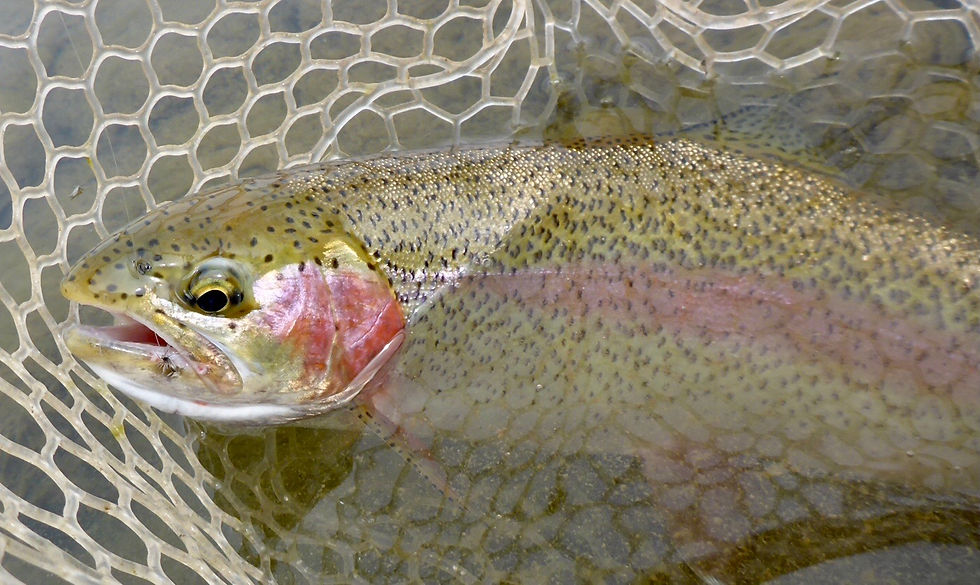
But at 4am the water board cut the flows to 90 cfs. Oh boy - change of plans. My thought was with the drastic change – the fish would seek shelter for a bit until they got acclimated to the new flows. So that meant going into the deeper holes instead of the wider sections of the river. At least the fish respond better to lowering of the flows as apposed to increasing them. So we made a minor adjustment.
We would start at the Hatchery Hole – if it was open. If not, we would go above it to the deep hole below the Cliffs Run. Then again move downstream – but hit the deeper holes along the way instead of the wider spots. As we drove down, Brian mentioned that the Hatchery Hole would most likely already be taken. There’s a guy he knows – I think his name is Ted – who fishes the hole every day in the early morning. Arriving at 8a would be too late.
Brian in front of the confluence of the Hatchery.

As we crossed the river to get to the Hatchery Hole – there was Ted. Fishing the hole and smoking his cigar. Brian briefly chatted with him and Ted reported some success with smaller fish. We then started up toward Cliffs Run. Brian decided to stick close to the Hatchery Hole and eventually joined Ted. I continued up to the deep hole below Cliffs Run.
It was about 8:30a when I finally got everything together and started to fish the deep pool. This pool covers the entire width of the river. It is formed by the placement of huge boulders across the river. This structure and others like it on this section of the Arkansas River are the result of the river improvement effort that the Colorado Fish and Wildlife and Trout Unlimited undertook a few years ago. There are a few nice seams that are formed by the water flowing over the boulders and the seams feed into tailouts.
A prolific midge hatch started at ~8:30a and didn't let up throughout the day.

I’ve only fished this spot once before and have found fish in the deeper section closest to the boulders. I’ve also spotted fish rising toward the back of the pool where the seams form distinct tailouts. As I began fishing the deeper part – I noticed some fish slurping just below the surface and also some rising. There was a good midge hatch in progress and that is what they were eating.
The tactic I tried first was to remove my weight and let my flies float to the surface at the end of the drift. I was trying to get the flies right in front of where the fish were slurping. My trailing fly was a #24 Top Secret Midge – one of my most reliable flies. But the fish ignored it. So I tried a #24 Zebra Jujubee Midge. It closely resembled an adult midge that I caught. But they ignored it too! Picky fish.
One of Brian's catches - a fat cutbow. (Notice the orangish coloration of her lower fins).
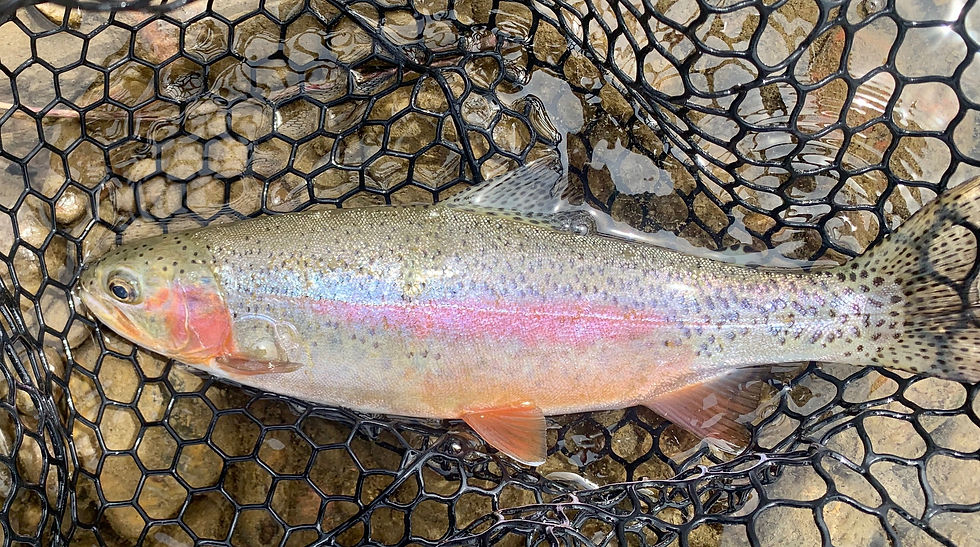
Photo by Brian Kenney.
And the some of the fish began to steadily rise. I like to see several fish rising in a pretty consistent pattern before I commit to going after them with dries. And that is what I was now seeing. So I waded to the shore and rigged up my dry fly setup. I tied on a Black Parachute Midge followed by a Matt’s Midge. When fish are eating adult midges – Matt’s is my go to.
I first went after some of the fish that were rising mid-river. But they were not as consistently rising as ones on the far shore. So I moved toward them – being careful not to spook them. After several tries I had one on. At first I thought it was a little one – not much fight. Then he began to take some runs and it was no little guy. It was an exciting fight and I had to slightly tighten my drag as it went along. But finally I had him my net – a nice 18” cutbow.
This rainbow took a #22 Black Beauty.
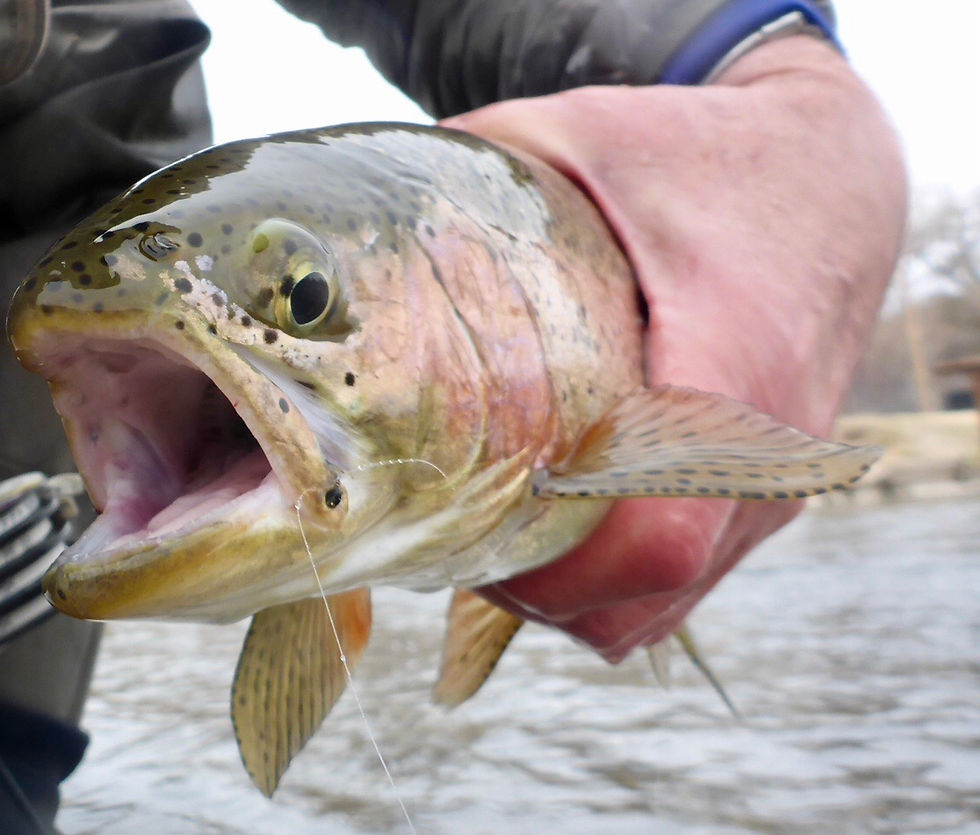
Other fish were still rising in the same seam where I caught the cutbow – so I continued to cast my dry flies to them. I missed a few – and after awhile I decided to head down and see how Brian was making out. Earlier he had told me that Ted usually only fishes until about 9a – then he heads out. And that was the case today. Brian now had the hole to himself.
When I met up with him – he was fishing dries to some rising fish at the end of the Hatchery Hole. I didn’t want to crowd him – so I was going to move further downstream to the Valco Ponds Run. But he pointed out where some fish were rising below where he was fishing and suggested that I try that spot. So I did.
Brian landed this 19" rainbow on a #22 Mercury Black Midge.

Photo by Brian Kenney.
The fish seemed to be picking off the flies from just below the surface and I couldn’t tell if they were nice size ones or little ones. Brian said there were some nice size ones in there. And he was right. I spotted a fish rising and casted to him. After a couple of drifts I got it right and he hit. I had a good hook set and he took off – line streaming out of my reel. Yep – there were some big ones in there. It was in the 18” range and a brightly colored rainbow. As he took off – he jumped out of the water – fully out of the water. And then he was gone.
What the heck happened? I inspected my flies – or fly that was all that was left – he broke my tippet that my Matt’s Midge was tied on with. Dang it! It happens sometimes when you catch a fish and fight it for a while – like I did earlier when I caught the 18” cutbow – your tippet could get nicked on something. Then when you hook up another fish – it breaks. Hard to plan for ahead of time.
One of Brian's fish was gorging on midges.

As we were fishing that spot – there were a bunch of swallows flying all around eating the midges that were hatching. The hatch was that heavy! It looked like a scene from the movie “The Birds”. It actually started when I was fishing in the deep pool below the Cliffs Run.
As before, I missed a couple of hits and then the rising stopped. Both Brian and I switched back to our nymph rigs and began to fish the Hatcher Hole. He was fishing the slower water mid-hole and I was fishing in the faster water at the top of it.
Here's Brian fighting a fish in the Hatchery Hole.

Then I did something I’ve never done before. I caught one of the birds! They were so thick that when I casted my flies they caught one of them in mid-flight. I was amazed and began to wonder how I would get him free. But before I had to deal with it – he somehow got himself free.
Nature in action again – birds gorging themselves on adult flies. Introduce a human with a fly rod in hand and some strange stuff happens!
This 19" rainbow also took a #22 Black Beauty.
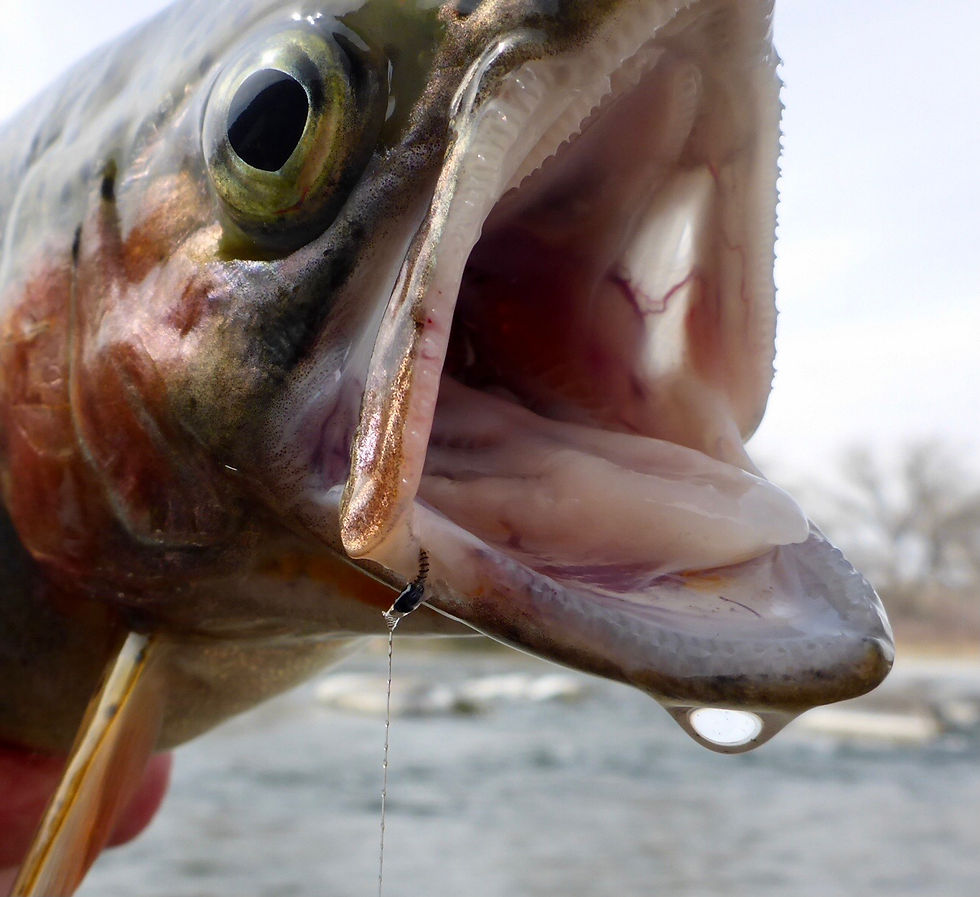
As we began nymphing - the fishing was slow. Then I hooked up another cutbow. I got him in the fast chute on the hatchery side of the river. He ended up being the biggest fish of the day for me – 19”. And he had a wide girth – I could barely get my hand around him. As I was working to free him – get got out of the net before I could get the fly out of his mouth. And my line was tangled in my net. So as I grabbed the line to pull him back – he proceeded to break off my line and swim away. With all my flies!
Just before landing that fish – I was about to ask Brian if he wanted to move downstream. And I was working to release my fish – Brian had one on. So I didn’t mention it. It began a pattern. Every time one of us mentioned if the other was ready to move on – we’d get a fish! At about 3p we agreed that it was now too late to go anywhere else. So we fished that hole until the end of the day. Except for a few forays to the slower water below the hole – where I ventured to get some rising fish on dries.
We caught a bunch of nice size fish. This is One of Brian's rainbows.
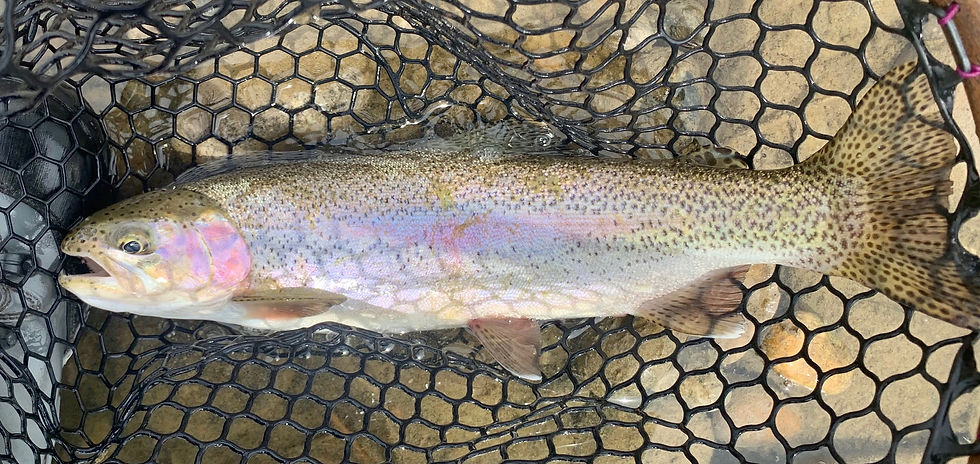
Photo by Brian Kenney.
Below the Hatcher Hole the river drains into a wide section of flat water. On the south side of the river (the Hatchery side) there is a seam of faster water about 3 feet wide that flows along that bank. The fish were rising there on a pretty good rhythm and some were rising more sporadically in the flat water in the middle of the river.
I couldn’t resist. But this time there was a BWO hatch in progress. The midges were still hatching too – but the trout were concentrating on the BWOs. I know this because I decided to first cast my Matt’s Midge to them to see if they’d hit it. And they didn’t. But once I changed to my Sparkle Dun – a BWO imitation – I got some action.
My smallest fish of the day - a 13" rianbow.

But I wasn’t able to get any to my net. I had a nice one on for a bit but he was able to spit my fly. And I missed a few more. It’s seems that if a fish hits your fly and you miss it – he won’t do it again. Same for when you hook one up. So I used up all my chits. Back to nymphing in the hole.
But that wasn’t so bad. The Hatchery Hole is a pretty reliable place to catch fish. It provides the perfect structure for fish to hang out in. You have faster water draining into slower water with various boulders scattered about that form seams for food organisms to gather and float in. And that’s where the fish hang out. And when there are adults on the surface the fish move to the tailout and eat them.
Here are 2 of my RS2s. Top row - Black Sparkle Wing RS2.
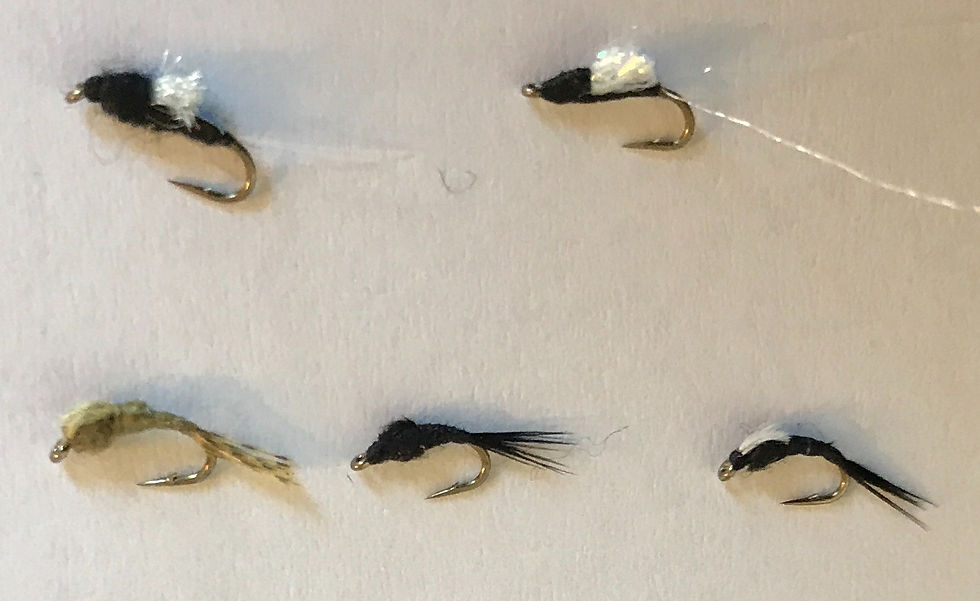
Meanwhile, as I was fishing below the hole for the rising fish - a guy named Rim Chung took my spot and was fishing in the Hatchery Hole with Brian. Brian had met him a while back while fishing in Deckers. Rim is pretty famous. He created one of the most effective fly patterns - the RS2. He originally created and used it on the South Platte River to imitate emerging beatis - but it's just as effective on all rivers and it's a go to fly for pretty much every fly fishing enthusiast.
When I finished fishing for the risers - I waded up near Brian and watched him and Rim fish. As Rim hooked up and landed a fish I asked him what the fish took. He walked over and showed my one of his creations. He called it the Avatar - its' basically an RS2 with no tail. He was fishing two of them in tandem - both black. One a #24 and the other a #26.
After Rim caught his fish I think he realized that Brian and I were buddies and fishing that hole - so he politely said he was moving on and gave the spot back to me. It's not every day that you run into someone like Rim. Hopefully we'll see him again on the river soon.
Another one of Brian's rainbows.

Photo by Brian Kenney.
The Hatchery Hole didn’t disappoint. Throughout the late morning and the rest of the afternoon Brian and I both had several fish in the net – and they all were in the 15” to 19” range – except for a 13” rainbow that I caught. They seemed to be keying on small - #24 to #26 midges. Even when the BWO where hatching - they still took the midges. Except for the risers that is.
A fun day on the river – enjoying nature with plentiful fish. Enough for both Brian and I –-- and the osprey.
Comments